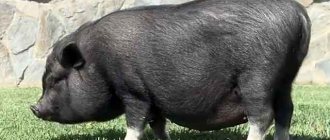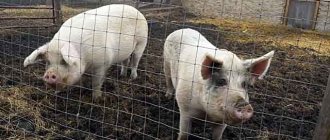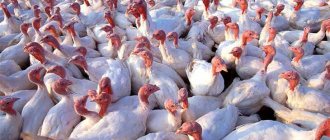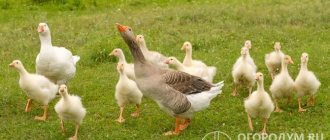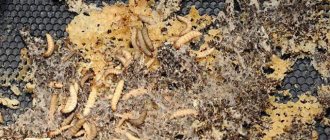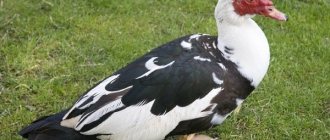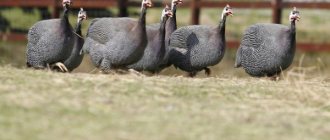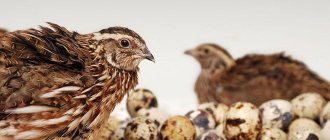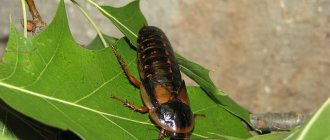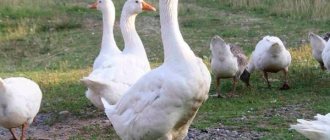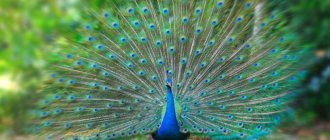Domestic livestock breeders are familiar with Vietnamese pot-bellied pigs relatively recently, but over the past decades, these “Asians” have gained great popularity and are widespread in many regions of Russia and other post-Soviet countries.
Vietnamese breed pigs (pictured) are unpretentious in care and undemanding when it comes to feed
The breed is not officially registered in the State Register of the Russian Federation, but experts consider it very promising and profitable , very suitable for keeping and breeding in personal households and farms. This opinion is based on the existing experience in raising Vietnamese pot-bellied pigs and the combination of their main characteristics:
| Parameter | Characteristic |
| Animal | Pig |
| Breed | Vietnamese (Asian) potbellied |
| Productive type | Bacon |
| Live weight of adults | Pig averages 100-120 kg (up to 140), boar – 120-140 kg (maximum up to 200 kg) |
| Age of puberty in pigs | 4 months |
| Multiple pregnancy | 4-6 piglets in the first farrowing, in subsequent farrows – 8-12 (up to 20) |
| Suit | Black (often with white spots on the head), sometimes white, red, marbled |
| Gaining live weight by the age of 7-8 months (optimal for slaughter) | 75-80 kg |
| Average daily weight gain | 250-500 g |
| Meat quality | High |
| Meat yield from carcass | 70-75% |
| The thickness of the subcutaneous fat layer at a live weight of 100-110 kg (by 10 months of age) | Up to 35 mm (with meat and fat fattening technology) |
| Disease resistance | High immunity |
| Registration in the State Register of the Russian Federation | Breed not included |
To learn more about the breed and the work to improve it, we suggest watching the following video:
History of the breed
The name of the breed is the result of a historical error. Vietnamese pigs were developed in Southeast Asia. But they came to Europe from Vietnam in 1985, which is why the breed began to be called Vietnamese. Vietnamese pigs were recently brought to Russia.
The work to improve the breed is not finished. It is especially active in Ukraine, Hungary and Canada.
The full correct name of the breed is Asian herbivorous pot-bellied pig.
Many people confuse representatives of this species with Korean pigs, or believe that Vietnamese and Chinese are the same animals. In fact, Chinese pigs are popular decorative mini pigs. Despite the huge external differences, they are truly related to the Vietnamese pot-bellied.
Description and characteristics of Vietnamese pigs
Vietnamese pigs are large animals. As an adult, an individual should weigh from 80 to 100 kilograms. Breeding representatives of the breed can weigh up to 150 kilograms. A pig gains weight during the first 5 years of life at a high rate. But gradually this process is slowing down. In wild boars, the fangs begin to grow at 6 months, and reach 10-15 centimeters.
Representatives of this breed do not differ in color variations. They can be:
- black (mostly common color);
- black and white.
A noticeable external difference between the Vietnamese breed and others is the drooping belly. It appears from the first month of life.
In terms of body structure, the animals are short, have short, even, strong legs, broad shoulders and chest, a large head with small erect ears, a flattened muzzle, and a snout with folds.
Meat productivity
Vietnamese pigs are not champions in weight, which is compensated by their excellent taste and rapid growth:
- the weight of a newborn boar is 500-600 g, a pig is 450-550 g;
- the average weight of an adult wild boar is from 120 to 140 kg, but some specimens can gain up to 200 kg;
- an adult pig weighs from 100 to 120 kg, the maximum recorded weight is 140 kg;
- per day, wild boars add 350-450 g, pigs 350-500 g;
- the optimal slaughter age is 7-8 months, upon reaching a live weight of 75-80 kg;
- slaughter yield from 70% to 75%.
Advantages and disadvantages of breeding Vietnamese pigs
It is not for nothing that the Vietnamese Fold is one of the most popular breeds of pigs. This was facilitated by a number of advantages:
- Rapid gain of slaughter weight. Already at 7-8 months, representatives of this breed reach 80 kilograms.
- Early puberty. Females are able to give birth at 4 months, while in wild boars the instinct to procreate awakens at six months.
- Fertility. A female can give birth to from 5 to 20 piglets, and produce offspring twice in a year.
- Ease of reproduction. Vietnamese potbellied sows are caring mothers who do not attack their piglets, unlike representatives of other breeds.
- Herbivory. This feature makes it easier for farmers to feed animals.
- High immunity. Diseases common to pigs do not affect Vietnamese potbellied pigs, so they do not need to be vaccinated.
- Memory for poisonous plants. The animal remembers which food harmed it and passes this knowledge through genes to subsequent generations.
- Cleanliness. Pigs of this breed always relieve themselves in the same place, located away from the sleeping and feeding area.
- Unpretentiousness to climatic changes. The breed easily tolerates extreme heat and cold.
- Peacefulness. Vietnamese pigs are non-aggressive, friendly, do not eat their piglets, do not bite, do not squeal, and are even capable of training.
- There is no unpleasant odor.
- Valuable meat. It is very tender and low in bad cholesterol.
The breed has few disadvantages. These include:
- Animal susceptibility to helminths.
- For Vietnamese pigs, drafts in the pigsty pose a particular danger.
Where to keep
Keeping Vietnamese pigs is not particularly troublesome. They don't need a big pigsty. It is best to surround the storage area with bricks and fill the floor with concrete.
In winter, to prevent animals from freezing, it is necessary to lay wooden scaffolds on the floor. Not the entire space, but only a certain part, which will serve as a sleeping place for the pigs.
The rest of the room is for food and toilets. The cleanliness of Vietnamese pigs is simply amazing. They don't spread manure around the pigsty. And they don't dig floors.
You need to organize a place for keeping it with the following calculation: 4.5 square meters of area for a couple of adults and one sow with a litter or wild boar. The machine must have good ventilation. Lack of air can negatively affect the health of pigs.
Although animals tolerate the cold calmly, in winter it is still better to heat the pigsty. Too low a temperature can kill the sow and newborn babies. The ideal temperature for their good growth is 20 degrees above zero.
How to choose piglets?
There are a number of rules by adhering to which you can purchase healthy and strong Vietnamese pot-bellied piglets:
- Buy piglets at the age of 1 month, then they will quickly and easily get used to the new environment.
- Find out from the breeder the baby's weight at birth and the dynamics of weight gain.
- Ask to see the piglet's parents; the quality of the offspring is determined by their appearance. Pay special attention to the sow, she should be thin and have sagging milk lobes. This is a sign that her piglets are about a month old.
- The cub itself should have strong legs, pronounced muscles and a sagging abdomen.
- For brood, do not purchase piglets from the same litter and from related parents. Their offspring will be sickly and abnormal.
- Pay attention to the mood of the little pigs. If they are in good health, they will wag their tails and play actively.
- When purchasing, ask the owner what kind of food he gave to the piglets. It will be possible to transfer young pigs to any other food, but gradually to avoid stool disorder.
Barley - for meat, oats - for lard
Manufacturers who want to obtain juicy dietary meat with a minimum amount of fat create a diet for fattening pot-bellied piglets from barley, wheat and rye. These grains contain a lot of highly digestible protein and contribute to the rapid growth of muscle mass. In the last months before slaughter, a pig can gain up to half a kilogram of live weight per day.
When feeding porridge made from oats, corn and peas, the weight of the Vietnamese pig will increase at the same rate. But this will occur due to the accumulation of fat and the formation of a relatively thick layer of lard (up to 3.5 cm).
To produce high-quality bacon, the diet of Vietnamese piglets is changed regularly, and the pigs themselves are constantly chased around the pen, thus reducing the amount of fat they accumulate.
An individual approach allows the farmer to feed a pot-bellied pet with the desired meat characteristics. You can find out more about this in the article “On feeding Vietnamese piglets at home.”
Conditions of detention, pigsty
Vietnamese pot-bellied pigs are unpretentious, but if you are planning a long-term breeding of this breed, then it is better to prepare carefully. To begin, build a pigsty:
- It should be strong and without cracks. It is better to make windows higher than the height of the pigs, so that air circulates, but does not blow through the animals. The optimal material for a pigsty is brick.
- It is advisable to fill the floor with concrete. This will make cleaning up after the pigs much easier.
- The pigsty is divided into pens by wooden partitions. “Flip-flops” are small in stature, so they need small sections.
- The departments have wooden flooring for sleeping.
- Heating is recommended. This breed can tolerate frosts, but will gain less weight. For the farrowing female and the offspring, low temperatures can be disastrous.
Vietnamese pigs are allowed to roam all year round. That's why they need an aviary. It should be fenced, with a canopy under which animals can hide from the heat and bad weather. It is recommended to dig in some rough logs that they will itch on and make a mud pool. Thanks to it, pigs will be able to cool down in the heat and drive away annoying insects. The water in the pool needs to be changed once a week.
Competent walking
Vietnamese pigs need fresh air. Daily walking in the warm season will provide animals with good immunity.
It has been noticed that pigs that walk regularly practically do not get sick and gain weight better. Captivity for this breed is destructive - the animals become weak and sick.
If there are no trees at the walking site, then it is better to dig a couple of logs in the area. Pigs love to rub their sides against them. It would be a good idea to organize a canopy so that animals can hide under it from bad weather and scorching sun rays.
Pigs love to bathe in mud to get rid of insects and cool down in the hot summer. Therefore, it is best to organize a pool for them - a small hole in the ground filled with water.
It is necessary to regularly add fresh water to the pool.
Feeding, products
Many inexperienced farmers, having learned that Vietnamese pot-bellied fish are herbivores, feed them with pasture alone. Pigs actually survive with this method of feeding, but the desired weight gain will not occur.
In addition to natural grazing, which guarantees fresh grass in the diet, it is worth providing “flip-flops” with:
- clover and alfalfa hay;
- fresh zucchini, pumpkin, carrots, apples;
- boiled potatoes;
- vitamin supplements.
Representatives of this breed are well fed with a grain feed mixture consisting of barley and wheat ground into flour. You can add a little legumes, oats and corn to it, but no more than 10% of the total mass. Otherwise, they will cause excess fat formation.
The taste of meat improves if pigs eat wet food. To prepare it, the grain mixture with the addition of 5-10 grams of salt is steamed with boiling water.
Sows should be given milk, eggs, whey, fish oil and vitamins. Additives are added to the cooled cereal porridge.
Vietnamese pot-bellied pigs have a small stomach and intestinal diameter, so they are not suitable for food:
- coarse feed;
- straw;
- fodder beet;
- high fiber foods;
- an abundance of corn, oats and peas in the feed.
When caring for this breed, it is necessary to regularly administer deworming medications.
Additionally, we recommend reading how to make your own feeder for pigs.
Feedback from livestock farmers
Yuri, 31 years old, Lviv region
Our people are not yet in a hurry to have Asian pigs, although they say that it is not just fashionable, but profitable. By the way, in neighboring Poland there are also very few of them, and in Hungary they are kept in almost every household. The Vietnamese are really very clean, calm, obedient and friendly. The grass is eaten both fresh and dry. If grazing is possible, they can produce good growth on pasture. And if you feed them with steamed feed, they will get fat right before your eyes.
Sergey, 46 years old, Usman
I raised my first Vietnamese dogs, they injected them today. At 8 months, the net weight was 40 kg, there was a little fat, about 2 cm. By this age, my plain white ones were already gaining about 80 kg. He fed them the same, gave the Vietnamese more grass and some oat bran, and sometimes added scraps from the kitchen. Pigs are very friendly, they wag their tail like dogs when you enter a pigsty. The main thing is that neither the floor nor the logs are chewed, and the locks on the doors are not broken. When cutting, I didn’t like that the skin was drier and rougher than white skin, and it was not very easy to clean after scorching. But the meat and lard are more tender, I liked the taste. It makes sense to breed for yourself, but not for sale.
Oleg, 52 years old, Rechitsa
Duroc meat has the best taste, while Vietnamese meat is so-so. Depends largely on the diet. This breed of pig is of interest primarily to breeders for its multiple births. Crosses with white ones, for example, grow faster and have fat.
Anna, 45 years old, Omsk region
We dry Vietnamese piglets immediately after birth, castrate the boars and bite off their upper and lower fangs with wire cutters. If the fangs are not removed, they then grow up to 15 cm in length. We do not immediately tear off the umbilical cord, but spray it with Kubatol. When it dries a little, tear it off at a distance of 7-10 cm and again spray with Kubatol. This way you don’t have to bother with thread and stop the bleeding. After 2-3 days it dries out and falls off on its own, but you need to look at it and, in some cases, treat it again. At the same time, the piglets are given vitamins and iron.
Reproduction
The most important thing in breeding pot-bellied pigs is not to let the boar cover your relative. The offspring will be sick, have poor weight gain, and may be infertile. To prevent this, you need to know the signs that a female is ready for mating:
- anxiety and nervousness;
- swelling of the genital loop;
- discharge from the genitals appears;
- freezing in place when pressure is placed on the croup.
Although females reach sexual maturity at 4 months, and in some cases earlier, they should be bred only when they gain sufficient weight - 32-35 kilograms. Otherwise, the offspring will be frail, and the sow may not tolerate pregnancy and childbirth well.
A pregnant female carries piglets for 114-118 days. During her first farrow she will give birth to about 5 babies. Then on average there are 10-12, but their number can reach 20 pieces.
5-6 days before giving birth, the female will begin to worry and make a nest out of straw or hay. If the belly has dropped and colostrum appears on the nipples, farrowing will occur in the next 10-20 hours. You need to prepare for it:
- Clean the machine and put in fresh hay.
- Fence off and insulate the area for the piglets. In the first days, babies should be kept at a temperature of at least +20 degrees Celsius, and preferably at +30-32 degrees.
- Increase the overall heating of the pigsty.
- Make sure that the female always has clean water. She will not feed on the day of birth.
Many people do not interfere with the birth process and do not touch the piglets for the first days. But this can result in the death of the cubs, especially during the female’s first farrowing. Babies are born very hungry, and if the sow does not have colostrum in advance or soon after farrowing, they may die. Therefore, you need to prepare in advance for the birth itself:
- backup option for feeding newborn piglets;
- diapers for wiping and wrapping;
- a clean flannel cloth to clear mucus from the eyes and respiratory tract;
- disinfectant (for example, chlorhexidine solution);
- scissors and thread to sew up the umbilical cord;
- iodine and cotton wool to cauterize the wound.
Childbirth in a Vietnamese sow lasts from 3 to 5 hours. The end of the process is indicated by the release of the placenta.
Elite meat of adult animals
The densest meat comes from an adult boar or sows. In its structure, it is practically indistinguishable from young piglet of conventional breeds. It is just as juicy and delicate in taste, and does not require much effort when preparing delicious dishes.
Very often in markets, some unscrupulous sellers deliberately mislead buyers by presenting Vietnamese pork as pig meat, and vice versa.
Pot-bellied boar meat is practically no different from ordinary pork, but is less fatty. In an adult sow, on the contrary, it contains more fatty layers.
When breeding pot-bellied pigs of different sexes, you can get meat of various qualities, which is perfect for preparing any dishes.
The only problem remains the slaughter of knur or uncastrated wild boar, the meat of which may have an unpleasant taste and be completely unsuitable for consumption.
Raising offspring
The piglets are surrounded by the care of their mother; her milk gives them all the necessary substances for the first days of life. But strong babies can push weaker ones away from the nipples, this needs to be monitored and everyone should be helped to have access to nutrition.
There is no iron in sow milk. This often leads to anemia in piglets. Therefore, they are given injections into the muscles of iron-containing preparations for animals, the dosage and number of injections is according to the instructions.
Additives are introduced into the diet of weekly offspring:
- chalk;
- charcoal;
- calcium;
- phosphorus.
On the tenth day, they are provided with a drinking bowl with clean water; by this time, the weight of each baby should be at least 1 kilogram. On the twentieth day, porridge from mixed feed with vitamins is introduced into the diet. A one-month-old piglet is already fed adult food. At this age he weighs 3 kilograms and can be sold.
Weaning should not be done one day, but gradually, offering babies an alternative to milk. Otherwise, the piglets will have a nutritional disorder, and the sow will have mastitis.
At the age of 40 days, anthelmintic procedures can be performed on piglets. For example, give the drug Brovadazole.
Long-term cold treatment
If the pig was young and the skatole content in its muscles is insignificant, then you can proceed to marinating this meat using spices in cooking.
But in most cases, when heated, the meat can again smell unpleasant. Then you need to change the solution again, leaving the product in it for two days. In some cases, it is necessary to carry out a similar replacement of the solution again and continue soaking for 2-3 days.
As a rule, after such procedures, the smell of skatole becomes almost indistinguishable, and the meat can be placed in a marinade with plenty of onions and spices.
Another way to remove unpleasant odors is to freeze meat at low temperatures. Skatole is destroyed and loses its properties with prolonged exposure to temperatures below minus 25 degrees Celsius.
Therefore, you need to cut the problem pork into pieces of 400-500 g and place it in the freezer for up to three months.
If the concentration of harmful substances is too high, then you should stop eating such meat and feed it to pets.
Breeding Vietnamese pigs as a business
The cost of a Vietnamese pot-bellied piglet is 3,000 rubles, and an adult piglet is 8,000 rubles. For breeding, it is enough to buy 2 females and 1 boar.
Housing conditions and feeding of this breed do not require large investments. As a result, all costs will be recouped within one year.
The nutritional properties and low content of bad cholesterol, rare for pork meat, make Vietnamese pot-bellied pigs unique, which increases their value. They are in high demand at farmers' and food markets.
At meat markets, the meat of young teenage pigs is especially valued. But more often adult animals weighing 80-100 kg are sent to slaughter.
You can learn more about keeping, feeding and breeding Vietnamese pot-bellied pigs by watching this video:
At the moment, the Vietnamese pot-bellied pig is the most profitable for home breeding. She grows quickly, produces large offspring, has high immunity, and an easy-going character. Its meat differs from the meat of other pig breeds in that it has more beneficial characteristics. The costs of keeping the animals are minimal and are fully covered by the sale of the first farrow.
0
0
Copy link
Dietary meat with different tastes
Depending on the composition of the feed mixture, which is added to the food of fattening pot-bellied piglets, their meat can acquire different qualities, becoming almost completely fat-free, or acquiring a large amount of fatty layers.
In large pig farms, Vietnamese pigs are fed fairly uniformly, achieving stable meat standards that are in demand in large retail chains and meet the requirements of the state standard.
Private producers of Vietnamese pork and owners of small farms can adjust the diet, ensuring that the meat acquires certain characteristics that differ from each other and are popular with gourmets. It can be sold to restaurant chains at a very high price, making a serious profit.
Conventionally, Vietnamese pig meat can be divided into several classes:
- low-fat pork for dietary dishes;
- meat with layers of fat;
- bacon with a lot of meat layers;
- salo.
